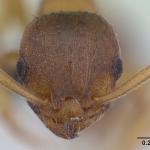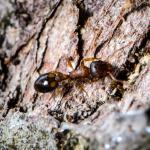Together with all but one of the ants previously included in Leptothorax (Myrafant), this species is now placed in Temnothorax (Bolton 2003). Queens and the small pale yellow to yellowish-brown workers are immediately distinguishable from other British and Channel Islands Temnothorax species by having antennal clubs the same colour as the rest of the antennae. The workers are also distinguishable by their possession of a mesopropodeal furrow - seen in profile as a depression on the dorsal surface of the alitrunk separating the mesonotum and propodeum. Individuals morphologically intermediate between workers and queens are not uncommon (Plateaux 1970).
Temnothorax nylanderi occurs locally throughout southern England and in South Wales, and is present in Jersey and Sark. Elsewhere, it occurs in western Europe and the western part of central Europe, reaching as far north as Denmark and southern Sweden (Czechowski, Radchenko & Czechowska 2002).
Neither Shirt (1987) nor Falk (1991) list T. nylanderi as scarce or threatened in Britain.
Temnothorax nylanderi inhabits parks and woodland where it generally nests in cavities in sticks and rotting branches, in tree stumps, at the base of tree trunks and under bark. The abandoned galleries of wood-boring insects are sometimes used. Foitzik & Heinze (1998) report nests in hollow acorns and grass stems from Germany. Unlike other British Temnothorax species, T. nylanderi shuns intense sunlight and high temperatures and favours shaded, sheltered positions (Pontin 1996; Blacker & Collingwood 2002).
Alate males and females are produced during July. Mating flights occur on warm evenings in August during the 2-3 hours before sunset (Plateaux 1978, 1984).
Colonies are small, with 100-200 workers and a single, singly-mated queen (Foitzik, Haberl, Gadau & Heinze 1997). If sufficient nest sites are available, a colony may fragment during spring and summer. Conversely, a shortage of nest sites can lead to the merging of unrelated colonies, generally with only one queen surviving the amalgamation (Foitzik & Heinze 1998). Although a newly-mated queen is capable of founding a colony on her own (Plateaux 1970), young mated queens may seek adoption by an established nest. In the latter case, the alien queen remains passive in the face of initial attack. Later she attacks the resident queen, workers and brood, and queen-queen aggression leads to the elimination of one of the queens (Stratz, Strehl & Heinze 2002). Workers can lay eggs which develop into males, but only start to do so if their colony loses its queen (Heinze, Puchinger & Hölldobler 1997).
Workers forage singly but will recruit individual nestmates to a food source using a combination of transient chemical and contact signals (Hölldobler & Wilson 1990).
2006



